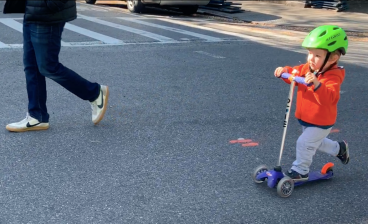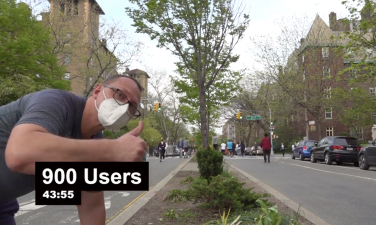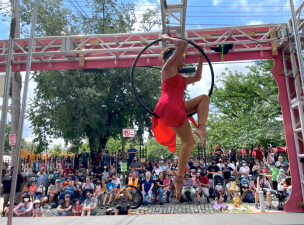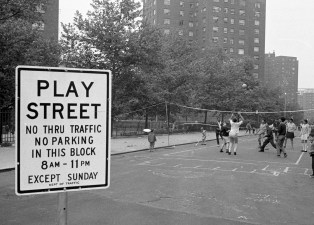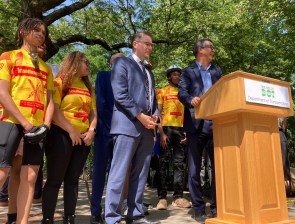HOT TOWN: ‘Cool Streets’ Program Marred By Grave Danger — Cars

Hot damn!
The city’s “Cool Streets” program — which launched Monday with just 16 blocks as car-free play streets with open fire hydrants for kids — is functionally useless, a Streetsblog spot check reveals.
What it lacks in cooling, it more than makes up for by asking children to go out and play in traffic.
“It would feel a bit safer without cars, [especially] since kids play in here,” said Tykwan Reid, who was trying to enjoy W. 138th Street in Harlem with his daughter, Nala. The pair had to consistently shift out of the way of cars; Reid said drivers “usually” slow down on the open street block between Lenox Avenue and Adam Clayton Powell Boulevard.
Usually.
Reid and his daughter were two of the very few users of the four “cool streets” visited by this reporter as temperatures went deep into the 90s on Monday. The problem is a program that is literally left to chance (or, more actually, the whims of the local police precinct), as drivers rule roadways that are supposed to be barricaded.
First, the good news: All of the streets — Jackson Ave. between E. 145th and E. 144th sts. and E. 140th St. between Brook and Willis avenues in The Bronx; and W. 138th St. and E 101st St. between Park and Lexington avenues in Manhattan — did, indeed, have a hydrant with a spray cap dispensing water.
That’s where the good news ended:
- None of the sites had proper police sawhorses or barricades in the street, so cars were a constant threat. All of the roadways were supposed to be set up by the local police precinct, except Jackson Avenue, which is a parks-adjacent play street.
- Discarded, unused barricades littered the streets.
- Only one hydrant per block actually dispenses water — and on Jackson Avenue and E. 101st Street, the water pressure was so low it was merely a trickle.
- There is no signage indicating any official city involvement, or encouragement for people to cool off.
- Stored cars lined both sides of both streets, cutting into the amount of play space.
Given the conditions, it wasn’t surprising when one Harlem resident, who gave the name Kay, surveyed the block and said, “I didn’t know they did that on purpose.”
The problems on the four streets we visited on Monday were reminiscent of the struggles within the larger Open Streets program, which has repeatedly come under fire for inconsistent implementation, especially when police precincts are involved. On Avenue B earlier this month, residents successfully petitioned the city to allow them to “take over” the operation of the barricades from the NYPD, which had done a poor job, residents said.
The failure of “cool streets” comes against the backdrop of a coronavirus pandemic that has disproportionately afflicted communities of color, which are also affected by soaring unemployment, police brutality and even the loss of basic amenities such as public pools. Properly closing some streets to cars and opening up hydrants seems to be the bare minimum.
In addition to cool streets, the de Blasio administration said it would deploy 320 sprinkler caps during heat advisories. They can be found at this website (marked with red circles on the map; some neighborhoods have no open hydrants at all).
A City Hall spokesman said that the Department of Environmental Protection did raise the pressure at the pump on Jackson Avenue after Streetsblog inquired about it. The official also said that cool streets that were chosen were located high “heat vulnerability” areas of the city on blocks with hydrants that turn on automatically during heat emergencies.
